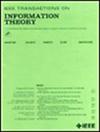单边图的零误差容量
IF 2.2
3区 计算机科学
Q3 COMPUTER SCIENCE, INFORMATION SYSTEMS
引用次数: 0
摘要
本文研究了用图形表示的具有存储器的信道的零误差容量。我们提供了一种方法来构造任何有一条边的图的代码,从而确定其零错误容量的下界。此外,该代码在一次顶点的符号相同的情况下可以实现零错误的能力。我们进一步将我们的方法应用于表示具有两个存储器的二进制通道的单边图。有28种可能的图,根据它们的对称性可以分为11类。用我们的方法构造的代码被证明对除情形11中的两个图外的所有图都具有零错误能力。本文章由计算机程序翻译,如有差异,请以英文原文为准。
On Zero-Error Capacity of Graphs With One Edge
In this paper, we study the zero-error capacity of channels with memory, which are represented by graphs. We provide a method to construct code for any graph with one edge, thereby determining a lower bound on its zero-error capacity. Moreover, this code can achieve zero-error capacity when the symbols in a vertex with degree one are the same. We further apply our method to the one-edge graphs representing the binary channels with two memories. There are 28 possible graphs, which can be organized into 11 categories based on their symmetries. The code constructed by our method is proved to achieve the zero-error capacity for all these graphs except for the two graphs in Case 11.
求助全文
通过发布文献求助,成功后即可免费获取论文全文。
去求助
来源期刊

IEEE Transactions on Information Theory
工程技术-工程:电子与电气
CiteScore
5.70
自引率
20.00%
发文量
514
审稿时长
12 months
期刊介绍:
The IEEE Transactions on Information Theory is a journal that publishes theoretical and experimental papers concerned with the transmission, processing, and utilization of information. The boundaries of acceptable subject matter are intentionally not sharply delimited. Rather, it is hoped that as the focus of research activity changes, a flexible policy will permit this Transactions to follow suit. Current appropriate topics are best reflected by recent Tables of Contents; they are summarized in the titles of editorial areas that appear on the inside front cover.
 求助内容:
求助内容: 应助结果提醒方式:
应助结果提醒方式:


